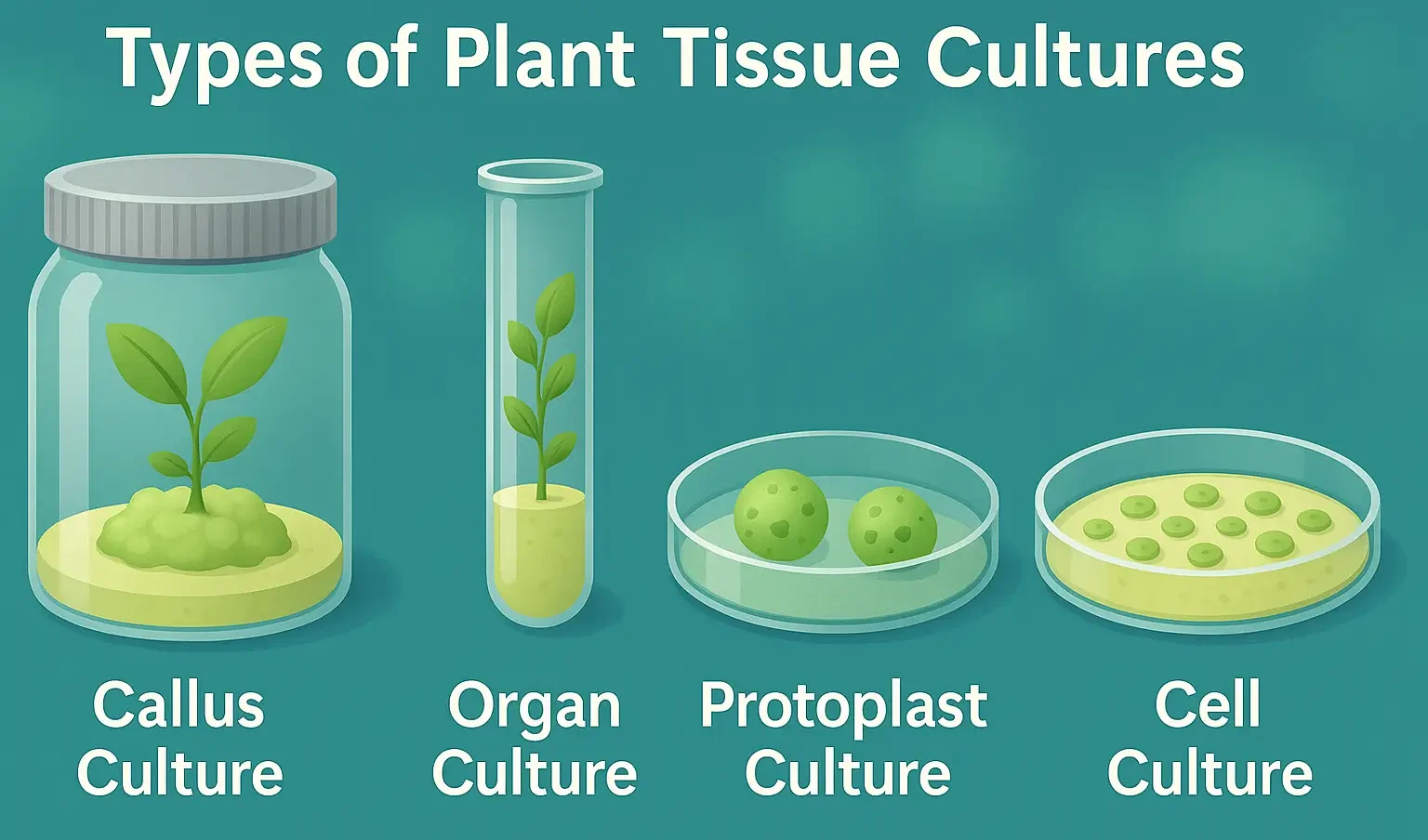- Types of Plant Tissue Cultures include callus, suspension, organ, meristem, and protoplast cultures for plant propagation.
- Plant tissue culture techniques vary depending on the part of the plant being cultured and the objective of the study.
- Below are the major types of plant tissue cultures, each with its unique methodology and applications.
1. Callus Culture
Definition:
- Callus culture involves the growth of an unorganized mass of plant cells (callus) derived from explants (leaf, stem, root, or other plant parts) under sterile conditions on a nutrient-rich medium containing plant growth regulators.
Procedure:
- Select an explant (e.g., leaf, stem, root).
- Sterilize the explant to prevent contamination.
- Place it on solid nutrient medium (e.g., Murashige and Skoog (MS) medium) containing auxins (e.g., 2,4-D, NAA) to stimulate callus formation.
- Incubate in a controlled environment (temperature: 25±2°C, photoperiod: 16 hours light/8 hours dark).
- After a few weeks, the explant swells, and callus develops.
Applications:
- Used in genetic transformation and somaclonal variation studies.
- Source for suspension cultures to produce secondary metabolites.
- Precursor for shoot or root regeneration in micropropagation.
Advertisements
2. Suspension Culture
Definition:
- Suspension culture involves growing single cells or small clusters of cells in a liquid nutrient medium under constant shaking.
- It is widely used for the large-scale production of secondary metabolites.
Procedure:
- Obtain callus tissue from an explant.
- Transfer small pieces of callus into a liquid medium.
- Place the culture on a shaker (80-120 rpm) to prevent cells from settling.
- Maintain in controlled conditions (temperature, pH, and aeration).
- Subculture at regular intervals to maintain growth.
Applications:
- Large-scale production of plant secondary metabolites (e.g., taxol, quinine, vinblastine).
- Used in studying cell division and differentiation.
- Essential for protoplast isolation.
3. Organ Culture
Definition:
- Organ culture involves growing isolated plant organs (shoots, roots, or embryos) in vitro to study their development and function.
Types:
- Root Culture: Growing roots in vitro for studying root growth, nutrient absorption, and production of bioactive compounds.
- Shoot Culture: Used in micropropagation to obtain multiple shoots from a single explant.
- Embryo Culture: Used for embryo rescue in hybridization.
Advertisements
Applications:
- Studies of organogenesis (formation of organs).
- Micropropagation of plants.
- Conservation of rare and endangered species.
4. Protoplast Culture
Definition:
- Protoplast culture involves isolating and culturing plant cells without cell walls.
- This technique is used in genetic modification and somatic hybridization.
Procedure:
- Digest the cell walls of plant cells using cellulase and pectinase
- Isolate the protoplasts and transfer them into an osmotic stabilizing medium.
- Culture in liquid or solid medium to induce regeneration of the cell wall.
- Stimulate cell division and shoot regeneration using growth regulators.
Advertisements
Applications:
- Somatic hybridization (fusion of protoplasts from different species).
- Genetic transformation.
- Studying cell wall formation and plant regeneration.
5. Embryo Culture
Definition:
- Embryo culture involves growing an isolated embryo in vitro, bypassing seed dormancy or hybridization barriers.
Procedure:
- Excise an immature or mature embryo from a seed.
- Sterilize and culture on a nutrient medium.
- Induce germination and plantlet formation.
Applications:
- Overcoming seed dormancy.
- Embryo rescue in interspecific hybridization.
- Conservation of rare plant species.
6. Anther and Pollen Culture (Haploid Culture)
Definition:
- Anther or pollen culture involves culturing anthers (male reproductive organs) or pollen grains in vitro to produce haploid plants.
Procedure:
- Collect immature anthers or pollen.
- Culture on a nutrient medium with cytokinins and auxins.
- Under stress conditions, pollen grains develop into haploid plantlets.
- Haploid plants can be doubled using colchicine to produce homozygous diploids (useful in plant breeding).
Advertisements
Applications:
- Development of homozygous diploid plants for breeding programs.
- Producing genetically uniform lines.
- Accelerating hybrid plant breeding.
7. Micropropagation
Definition:
- Micropropagation is the mass production of genetically identical plants (clones) using tissue culture techniques.
Stages of Micropropagation:
- Initiation Stage: Selection and sterilization of explants.
- Multiplication Stage: Shoot proliferation using cytokinins (e.g., BAP, kinetin).
- Rooting Stage: Root induction using auxins (e.g., IBA, NAA).
- Acclimatization Stage: Gradual adaptation of plantlets to external conditions.
Applications:
- Commercial production of ornamental and medicinal plants.
- Conservation of rare and endangered species.
- Large-scale production of disease-free plants.
Comparison of Different Types of Tissue Culture
| Type of Culture | Explant Used | Nature of Growth | Major Application |
| Callus Culture | Any plant part | Unorganized mass | Genetic modification, somaclonal variation |
| Suspension Culture | Callus cells | Single cells in liquid | Secondary metabolite production |
| Organ Culture | Root, shoot, embryo | Organized growth | Organogenesis studies, conservation |
| Protoplast Culture | Isolated protoplasts | Regeneration of cell wall and plant | Somatic hybridization, genetic engineering |
| Embryo Culture | Isolated embryo | Development into plant | Overcoming dormancy, hybridization |
| Anther/Pollen Culture | Anther, pollen | Haploid plant formation | Breeding and hybrid plant development |
| Micropropagation | Shoot tips, meristems | Clonal propagation | Large-scale plant production |

